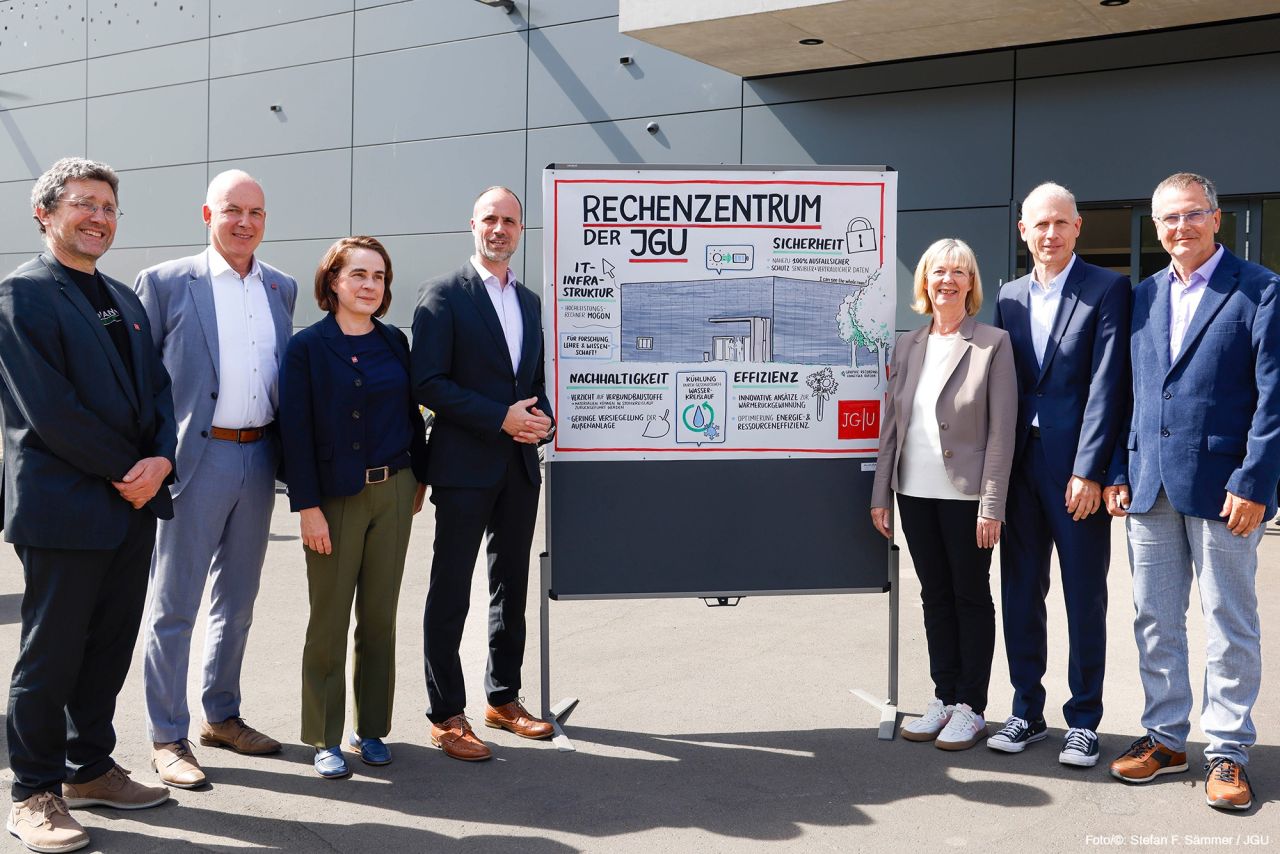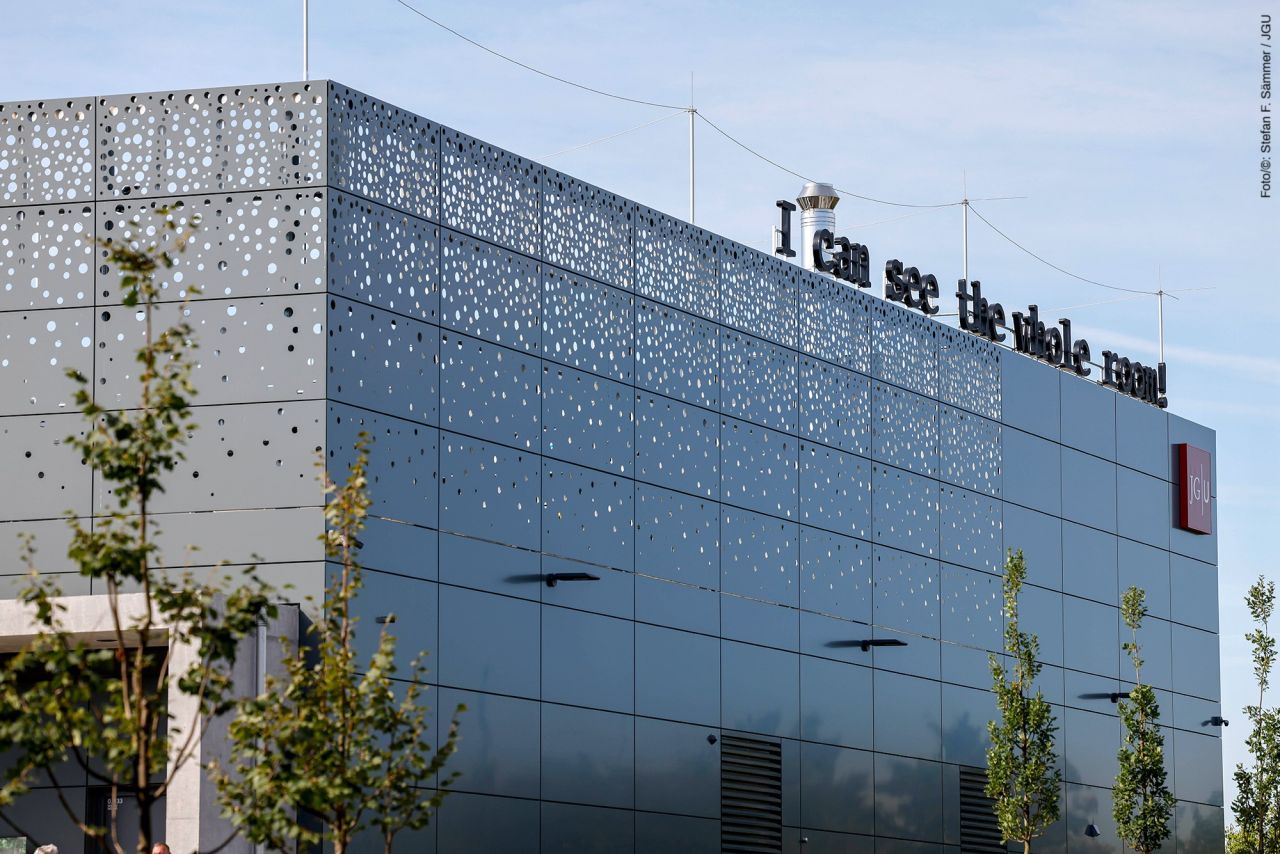Johannes Gutenberg University Mainz (JGU) has reached an important milestone: after two years of intensive construction, the new data center on the Gutenberg Campus is now operational. Finance and Construction Minister Doris Ahnen, Science Minister Clemens Hoch, and JGU President Professor Dr. Georg Krausch officially opened the new facility today together with many guests from politics, IT, and science.
The new building is of crucial importance: it houses both the university’s IT infrastructure, essential for academic operations and administration, and the systems for National High-Performance Computing (NHR). To optimally support cutting-edge research and university operations, JGU placed particular emphasis during planning and implementation on security, availability, and system performance.
“The new data center is another important step in the ongoing renewal of higher education infrastructure, both here on the JGU campus and across other university sites in Rhineland-Palatinate. Modernization and expansion of our state’s universities are among our most important tasks. The data center sets benchmarks technically, economically, and ecologically. Its optimized energy and resource efficiency, with highly efficient cooling systems, heat recovery, and photovoltaic power generation, make it both highly functional and sustainable. Almost €31 million in construction costs have been approved, an excellent investment in Mainz as a research hub,” said Doris Ahnen, Minister of Finance and Construction of Rhineland-Palatinate.
Science Minister Clemens Hoch also congratulated JGU on the opening: “The new data center is not only an outstanding example of the technological capabilities and innovative strength of JGU, it is also a flagship for Rhineland-Palatinate as a center of research. The fact that such a complex construction project was completed swiftly and with careful planning deserves great recognition. I wish the university every success with this forward-looking facility. It will strengthen digitally supported research and teaching as well as high-performance computing, and it will enhance JGU’s visibility as an excellent site for research infrastructure far beyond our region.”
Future-proof and sustainable IT infrastructure for teaching, science, and research
The building combines two functional areas:
- One section houses the university’s entire IT infrastructure, as well as the systems required for the Rhineland-Palatinate science network and services offered as part of the Data Center Alliance of Rhineland-Palatinate (RARP).
- The other section accommodates the MOGON NHR South-West supercomputer and the planned successor system to MOGON II.
“The new data center sets new standards for the university and for science,” emphasized JGU President Professor Dr. Georg Krausch. “For researchers in Mainz, Rhineland-Palatinate, and throughout Germany, a state-of-the-art, high-performance IT infrastructure is indispensable, whether it is the Rhineland-Palatinate science network or interconnected high-performance computing as a key technology for top-level research. This investment in our Data Center ensures that research groups dependent on powerful HPC resources can maintain and expand their leading positions.”
The data center has been designed to guarantee nearly 100% operational reliability, ensuring that critical services such as email, learning management systems, and databases are always available. Four predefined security zones and a specialized access control system with airlocks safeguard sensitive and confidential data, including research results and personal data of students and staff.
Alongside security and efficiency, sustainability was a central aspect of the concept. To reduce its ecological footprint, JGU equipped the new building with a range of innovative, environmentally friendly technologies, including:
- Photovoltaic modules on unused roof space
- Server cooling with a closed water circuit, largely without compressor-based refrigeration (relocating the MOGON NHR South-West HPC cluster alone saves around €200,000 in electricity costs annually)
- Heat recovery systems with future use of waste heat for building heating, thereby optimizing energy and resource efficiency
- Avoidance of composite building materials, allowing future recycling of materials
- Minimal sealing of outdoor areas, with full rainwater retention and drainage into swales for evaporation or reuse
Construction of the data center was overseen by JGU, to which the state of Rhineland-Palatinate delegated the role of client. “The new facility was built by JGU in cooperation with Landesbetrieb LBB and in consultation with the Finance Ministry’s construction department,” explained JGU Chancellor Dr. Kerstin Burck. “Our chosen approach ensured that we stayed within budget, met the completion deadline, and provided an optimal IT infrastructure.”
A place for art as well as technology
The building also integrates art: mounted on the rooftop edge glows the phrase “I can see the whole room! … and there’s nobody in it!”, a reference to Roy Lichtenstein’s 1961 work reflecting on the uncertainty of perception through technical devices. Artist Thorsten Goldberg chose the typeface “Courier” to underline the connection with the digital world of the data center.
Facts and Figures
- Total floor space: 1,870 m² (approx. 1/4 of a football field)
- Construction costs: €30.75 million
- PUE (Power Usage Effectiveness): ≤ 1.15
- 32 server racks in the enterprise area and 112 server racks in the HPC area (up to 84 in operation simultaneously)
- Maximum IT load: 3,600 kW
- Photovoltaic modules: 73 kWp
- Certified according to DIN EN 50600 (European standard for data centers, covering availability, reliability, security, energy efficiency, and sustainability)
- Availability classes: Enterprise area – Class 3; HPC area – Class 2



Related links
https://nhrsw.de/ – NHR South-West
Contact
Press and Public Relations
Johannes Gutenberg University Mainz (JGU)
55099 Mainz, GERMANY
phone: +49 6131 39-22369
e-mail: presse@uni-mainz.de
www.uni-mainz.de/